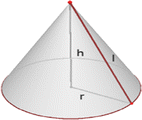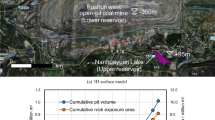Abstract
Sustainable development is a concept that was introduced almost at the end of the twentieth century and quickly entered the literature. In recent years, the concept of sustainability and sustainable development (SD) has been successfully extended to mineral resources, but there have been few attempts to consider this concept in the ultimate pit limit (UPL) design. The problem of UPL determination is the first step in the open pit mine design and planning process. There are several mathematical, heuristic and meta-heuristic algorithms to determine UPL. The objective function in these algorithms is the maximization of total profit. Few models integrated some aspects of mining reclamation benefit and cost in the UPL design. However, there is not any comprehensive method for UPL design based on SD considerations. This paper provides a model for UPL designing based on SD indicators. According to this model, it is possible to integrate the SD principles in UPL design. The proposed model is explained by a simple 2D example and applied in an iron mine as a case study. Generally, using SD principles in UPL design may lead to a larger UPL than traditional method (profit maximization). The suggested method is appropriate for those ore bodies with no underground option. In cases with the underground option, before applying the suggested method, the transition level from surface to underground shall be determined.





















Similar content being viewed by others
References
Amankwah H (2011) Mathematical optimization models and methods for open-pit mining. Linköping Studies in Science and Technology, Dissertations No. 1396, Linköping University
Ataee-pour M, Rahmanpour M, Adibee N (2012) Ultimate pit limit optimization with simultaneous maximization of profit and ore content. In: 4th Iranian mining engineering conference, Tehran University, Iran, pp 145–151
Azapagic A (2004) Developing a framework for sustainable development indicators for the mining and minerals industry. J Clean Prod 12:639–662. doi:10.1016/S0959-6526(03)00075-1
Badiozamani MM, Askari-Nasab H (2014) Integration of reclamation and tailings management in oil sands surface mine planning. Environ Model Softw 51:45–58. doi:10.1016/j.envsoft.2013.09.026
Burgher EK, Erickson E (1984) The optimization of coal mine production schedules using linear programming: an example that determines the effects of reclamation costs and interest rates. Min Sci Technol 2:69–78. doi:10.1016/S0167-9031(84)90223-8
Coccetta L, Kelsey PJ (2001) Models for mine site rehabilitation. In: International conference on models and simulation, pp 2155–2160
Craynon J, Karmis M (2011) Optimizing coal mine design for sustainable development at large surface coal mining operations in Appalachia. 5th international conference on sustainable development indicators in the mineral industry (SDIMI). Aachen, Germany, pp 75–82
De Palacios LDLT (2011) Natural resources sustainability: iron ore mining. Dyna 78(170):227–234. http://scielo.org.co/pdf/dyna/v78n170/a27v78n170.pdf. Accessed 30 Nov 2014
Dogan T, Bascetin A, Sertabipoglu Z (2009) The effects of changing block size on ore quality control and environmental impacts. 8th international Symposium on Mine Planning and Equipment Selection (MPES). Alberta, Canada, pp 301–310
Gholamnejad J (2009) Incorporation of rehabilitation cost into the optimum cut-off grade determination. J South Afr Inst Min Metall 108:89–94
Gholamnejad J, Mojahedfar AR (2010) Determination of the largest pit with the non-negative net profit in the open pit mines. J Min Environ 2(1):45–52
GRI (2005) GRI mining and metals sector supplement pilot version 1.0. Global reporting initiative. http://icmm.com/document/204. Accessed 30 Nov 2014
Hilson G (2000) Sustainable Development policies in Canada’s mining sector: an overview of government and industry efforts. Environ Sci Policy 3:201–211. doi:10.1016/S1462-9011(00)00086-1
IBRAM (Instituto Brasileiro De Mineracăo) (2012) Information and analysis on the Brazilian mineral economy. http://ibram.org.br/sites/1400/1457/00000380.pdf. Accessed 30 Nov 2014
King BM (1998) Impact of rehabilitation and closure costs on production rate and cut-off grade strategy. In: Conference on application of computers and operations research in the mineral industry (APCOM), London, UK, pp 617–629
Krajnc D, Glavic P (2004) Model for integrated assessment of sustainable development. Resour Conserv Recycl 43:189–208. doi:10.1016/j.resconrec.2004.06.002
Lerchs H, Grossmann IF (1965) Optimum design of open-pit mines. Trans Can Inst Min Metall 68:17–24
Mehrabi B, Karimi B (2004) Jalalabad iron deposit; example of hydrothermal iron deposit. In: Proceedings of 22nd geoscience symposium of Iran, Tehran, pp 125–134
O’Hara TA, Suboleski CS (1992) Costs and cost estimation. In: SME mining engineering handbook, 2nd edn, vol 1, Chap 6.3. Society for Mining, Metallurgy, and Exploration, United State pp 405–424
Picard JC (1976) Maximal closure of a graph and applications to combinatorial problems. Manag Sci 11(22):1268–1272. doi:10.1287/mnsc.22.11.1268
Rashidinejad F, Osanloo M, Rezai B (2008a) An environmental oriented model for optimum cut-off grades in open pit mining projects to minimize acid mine drainage. Int J Environ Sci Technol 5(2):183–194. doi:10.1007/BF03326012
Rashidinejad F, Osanloo M, Rezai B (2008b) Cutoff Grades optimization with environmental management; a case study: Sungun copper project. IUST Int J Eng Sci 19(5–1):1–13
Singh RK, Murty HR, Gupta SK, Dikshit AK (2007) Development of composite sustainability performance index for steel industry. Ecol Ind 7:565–588. doi:10.1016/j.ecolind.2006.06.004
UN (1992) Agenda 21. In: Proceedings of United Nations Conference on Environment and Development, Brazil, Rio De Janerio. http://un.org/esa/sustdev/documents/agenda21/english/Agenda21.pdf. Accessed 30 Nov 2014
World Commission on Environment and Development (WECD) (1987) Our common future. United Nations, http://un-documents.net/our-common-future.pdf. Accessed 30 Nov 2014
Author information
Authors and Affiliations
Corresponding author
Appendix 1: detailed calculations of indicators values for UPL3
Appendix 1: detailed calculations of indicators values for UPL3
-
(a)
Waste production = [(Waste quantity +ore quantity × (1-average grade)]
According to Fig. 7 the number of waste blocks in UPL3 is 35 and the number of ore blocks in UPL3 is 14. According to Fig. 2, the average grade of 14 ore blocks in UPL3 is (0.56 × 1+0.27 × 1 + 0.29 × 1 + … + 0.59 × 1)/14 = 0.38; Waste production = 35 + 14 × (1 − 0.38) = 44 ton.
-
(b)
Reclamation = ((pit wall surface) + (waste dump surface))
-
Pit wall surface in UPL3: 27 m2;
-
Waste volume in UPL3: 44 m3 (density is 1 ton/m3); It is assumed that waste dump shape is a cone with 45 degrees sides and all lateral needs reclamation. Therefore, the base circular radius of the cone (r) is equal to the cone height (h).
-
$$ {\text{Cone volume}}:V = \frac{1}{3}\pi r^{2} {\text{h }}\mathop \Rightarrow \limits^{r = h} \frac{1}{3}\pi r^{3} $$(10)
-
$$ {\text{Lateral surface area of the cone}}:S = \pi rl ,\;l = \sqrt {{\text{h}}^{2} + r^{2} } \mathop \Rightarrow \limits^{r = h} {\text{l}} = \sqrt 2 r $$(11)
-
Where, l is the slant height. Therefore: \(43.74 = \frac{1}{3}\pi r^{3} \Rightarrow r = 3.47\,{\text{m}}; l = 4.91\,{\text{m}}; S = 53.47\,{\text{m}}^{2} ;\)
-
Waste dump surface area for UPL3 = S = 53.47 m2, Reclamation of UPL3 = (27 + 53.47) = 80.47. m2

-
-
(c)
Land use = ((Surface of natural land inside pit collar before pit opening + land area that is covered by waste dumps))
According to Fig. 5, the surface of natural land inside the pit collar before pit opening for UPL3 = 12 m2; Land area that is covered by waste dumps is equal to the A.
$${\text{Base surface area of the cone}}:A = \pi r^{2}$$(12)\(r = 3.47\,{\text{m}}\), A = 37.81 m2; Land use of UPL3 = (12 + 37.81) = 50 m2.
-
(d)
Energy Consumption = [fm × ore + fw × mine waste]
Assumed fm = 5 and fw = 1; Energy Consumption = [5 × (14) + 1 × 35] = 105 energy unit
-
(e)
Job security = Life of mine = (ore in pit/ore production per year)
Life of mine = 14/3 = 4.7 year
-
(f)
Safety = Depth of mine = (highest bench level − pit floor level)
Safety = 7 − 0 = 7 m
-
(g)
Resource efficiency = (ore quantity in pit × average grade)/(orebody × average of orebody grade)
Resource efficiency = (14 × 0.38)/(26 × 0.35) = 0.58 %
-
(h)
Number of employees = (ore and waste blocks in level 1 + ore and waste blocks in level 2 × 1.1 + …)/(life of mine)
Number of employees = (13 + 11 × 1.1 + 9×1.2 + 7×1.3 + 5×1.4 + 3×1.5 + 1×1.6)/4.7 = 13 man
-
(i)
Profit = (sum of all blocks economic value in pit)
Profit = (35 × (−4) +3+6 + 7+29 + 18 + 22 + 14 + 14 + 32 + 8+3 + 20 + 9+31) = 73 $
-
(j)
Post mining income = [reclaimed land × ISL − land use × IPL]
Assumed Ipl = 0.01 $/m2 and IPL = 0.012 $/m2, Post mining income = (80.47 × 0.1 − 50 × 0.12) = 1.9 $
-
(k)
Taxes generation = sum of all taxes
Assumed tax on profit = 0.2, other taxes is 0.3$ per ton of excavated material (ore + waste), all customs duties = 0 Taxes generation = (73 × 0.2 + (14 + 35) × 0.3) = 29.23 $
-
(l)
Mining indirect benefit = sum of all mining indirect benefits.
Assumed 20 % of mining costs spent in the local community. Mining indirect benefit = [(14 + 35) × 4$ + 14 × 12$] × 0.2 = 72.8 $
Rights and permissions
About this article
Cite this article
Adibi, N., Ataee-pour, M. Consideration of sustainable development principles in ultimate pit limit design. Environ Earth Sci 74, 4699–4718 (2015). https://doi.org/10.1007/s12665-015-4434-3
Received:
Accepted:
Published:
Issue Date:
DOI: https://doi.org/10.1007/s12665-015-4434-3





